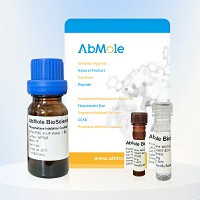
Zymosan A can increase the level of cyclin D2, suggesting the role of cyclin D2 in macrophage activation and proliferation. After injection of galactosamine, it aggravated acute liver injury, suggesting that some non-parenchymal cells besides Kupfer's cells were involved in fermentase action.
| Molecular Weight | 211.01 |
| Formula | C2H4BrNaO3S |
| CAS Number | 58856-93-2 |
| Solubility (25°C) | Insoluble in Water |
| Storage | -20°C, protect from light, dry, sealed |
| Species | Mouse | Rat | Rabbit | Guinea pig | Hamster | Dog |
| Weight (kg) | 0.02 | 0.15 | 1.8 | 0.4 | 0.08 | 10 |
| Body Surface Area (m2) | 0.007 | 0.025 | 0.15 | 0.05 | 0.02 | 0.5 |
| Km factor | 3 | 6 | 12 | 8 | 5 | 20 |
| Animal A (mg/kg) = Animal B (mg/kg) multiplied by | Animal B Km |
| Animal A Km |
For example, to modify the dose of Compound A used for a mouse (20 mg/kg) to a dose based on the BSA for a rat, multiply 20 mg/kg by the Km factor for a mouse and then divide by the Km factor for a rat. This calculation results in a rat equivalent dose for Compound A of 10 mg/kg.
[2] Wataru Ariyoshi, et al. Molecules. Biological Effects of β-Glucans on Osteoclastogenesis
| Related Products |
|---|
| Poly(ethylene glycol) diacrylate
Poly(ethylene glycol) diacrylate (PEGDA) is a blank slate hydrogel that gels rapidly at room temperature in the presence of a photoinitiator and light. PEGDA hydrogels are potent tools for uncovering basic cellular biology. PEGDA is an emerging scaffold for tissue engineering and regenerative medicine since polymerization can occur rapidly at room temperature, requires low energy input, has high water content, is elastic, and can be customized to include a variety of biological molecules. |
| Isothiuronium
Isothiouronium is a functional group, it is the acid salt of isothiourea. |
| Sultosilic acid, piperazine salt
Sultosilic acid piperazine salt is a compound with lowering lipid activity. It causes significant shortening of the euglobulin lysis time and a significant diminution of platelet adhesiveness, as well as statistically significant decrease of triglycerides, total cholesterol, beta- and pre-beta-cholesterol and an increase of alpha-cholesterol. |
| Ipamorelin
Ipamorelin (NNC-26-0161) is a a novel and potent ghrelin mimetic peptide compound that counteracts glucocorticoid-induced decrease in bone formation of adult rats. |
| PRGL493
PRGL493 is a potent and selective long-chain acyl-CoA synthetase 4 (ACSL4) inhibitor. PRGL493 blocks cell proliferation and tumor growth in both breast and prostate cellular and animal models. |


Products are for research use only. Not for human use. We do not sell to patients.
© Copyright 2010-2023 AbMole BioScience. All Rights Reserved.
